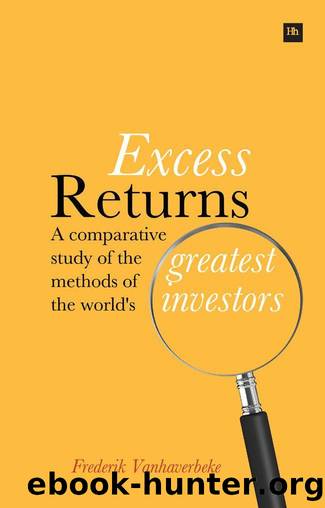Excess Returns: A Comparative Study of the World's Greatest Investors by Frederik Vanhaverbeke

Author:Frederik Vanhaverbeke [Vanhaverbeke, Frederik]
Language: eng
Format: epub
Tags: Business, E-Commerce, Economics, Investing, Investments & Securities, Non-Fiction, Online Trading, Personal Finance, Stocks
ISBN: 9780857193513
Google: BE7kAwAAQBAJ
Amazon: 0857193511
Publisher: Harriman House
Published: 2014-06-27T23:00:00+00:00
where P is the stock price and where:
1. earningsnorm are the normalised net or operating earnings. In the trailing P/E, this term is the earnings that have been reported over the previous X months. For the forward P/E, this term is the earnings expected in the coming X months. Commonly investors use 12 for X, which means that they use the earnings over the trailing 12 months (for the trailing P/E) or the earnings expected over the next year (for the forward P/E). The normalisation can be done by judiciously carrying out the following set of adjustments:
• The earnings should be as recurring as possible to avoid one-time anomalies that can distort the firm’s true earnings power. One should correct for extraordinary and nonrecurring items, for all changes that are deemed unsustainable (e.g., exceptional – but temporary – margin expansions), or even for items that from a reasonable point of view should not be included in profits. For instance, investors can decide to capitalise R&D costs that are expensed in the financial statements as R&D should pay off over the long term.
• If convertible bonds are included in the number of shares that are used to calculate P/E (see hereunder), one has to add back the interest expense of these convertibles to earnings since this expense will disappear upon conversion.
• In order to obtain a multiple that is comparable with that of other companies, one should put the earnings of all companies on the same footing through proper accounting adjustments. For instance, one must make adjustments for differences in depreciation methods, inventory methods, etc.
• Benjamin Graham and John Templeton used for X a much larger number than 12. They averaged the earnings over the last four to five years (i.e., X = 48 to 60) because this reduces distortions caused by the business cycle, by the profit margin cycle, by accounting practices and by extraordinary items.
2. Number of shares is the number of shares outstanding. If the company has convertible bonds, options and/or warrants outstanding, it is best to include those that are likely to be converted into common stock in the number of shares. Referring to the fact that the share base is likely to be diluted in the future due to this conversion, the resulting P/E is called the diluted P/E.
The fair P/E of a stock is determined by a number of factors:
1. Expectations: the fair P/E multiple is determined by the expectations about the company’s future. When a company’s prospects are bleak and/or uncertain, the fair P/E is usually lower than when the prospects are bright and/or stable. Elements that play an important role in the evaluation of a company’s prospects are:
• Expected earnings (cash flow) growth: all else being equal, companies with higher expected growth deserve a higher P/E than those with lower growth. Here are two ways to integrate the expected earnings growth into the evaluation of P/E ratios:
(i) Peter Lynch and John Templeton use the PEG ratio to determine the fair (12-month trailing) P/E ((P/E)trail) of a stock.
Download
This site does not store any files on its server. We only index and link to content provided by other sites. Please contact the content providers to delete copyright contents if any and email us, we'll remove relevant links or contents immediately.
| Analysis & Strategy | Bonds |
| Commodities | Derivatives |
| Futures | Introduction |
| Mutual Funds | Online Trading |
| Options | Portfolio Management |
| Real Estate | Stocks |
Pioneering Portfolio Management by David F. Swensen(5606)
Rich Dad Poor Dad by Robert T. Kiyosaki(5149)
How To Win Friends and Influence People by Dale Carnegie(3772)
The Money Culture by Michael Lewis(3284)
The Dhandho Investor by Mohnish Pabrai(3169)
The Wisdom of Finance by Mihir Desai(3079)
Liar's Poker by Michael Lewis(2812)
The Intelligent Investor by Benjamin Graham Jason Zweig(2596)
The ONE Thing by Gary Keller(2519)
Mastering Bitcoin: Programming the Open Blockchain by Andreas M. Antonopoulos(2511)
Investing For Dummies by Eric Tyson(2470)
How to Day Trade for a Living: Tools, Tactics, Money Management, Discipline and Trading Psychology by Andrew Aziz(2445)
How to Win Friends and Influence People by Dale Carnegie(2435)
Rich Dad Poor Dad: What The Rich Teach Their Kids About Money - That The Poor And Middle Class Do Not! by Robert T. Kiyosaki(2434)
Fooled by Randomness: The Hidden Role of Chance in Life and in the Markets by Nassim Nicholas Taleb(2413)
Zero Hour by Harry S. Dent Jr. & Andrew Pancholi(2246)
Market Wizards by Jack D. Schwager(2164)
Rich Dad's Guide to Investing by Robert T. Kiyosaki(2111)
How to Pay Zero Taxes, 2018 by Jeff A. Schnepper(2100)
